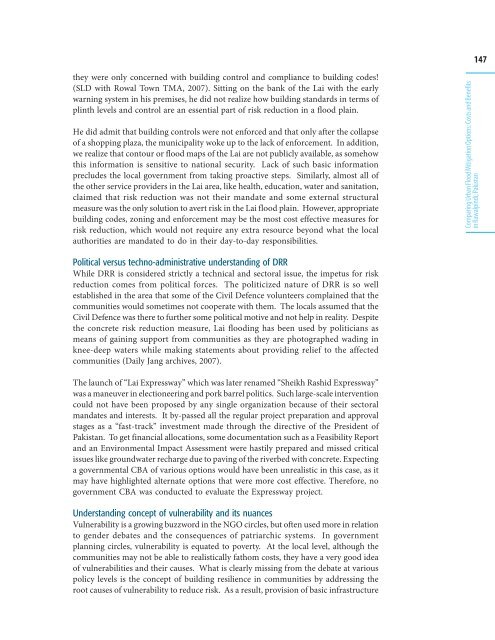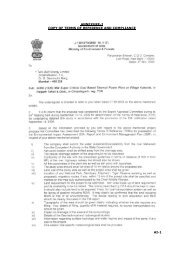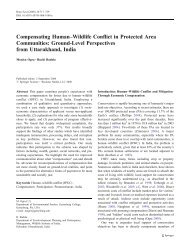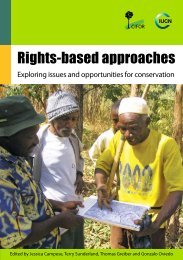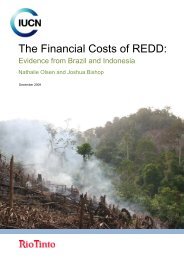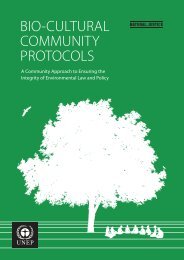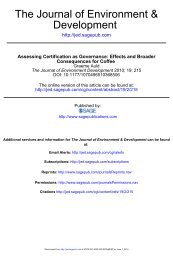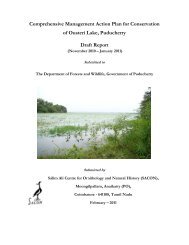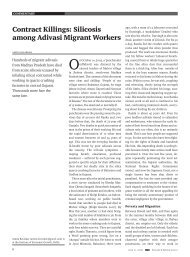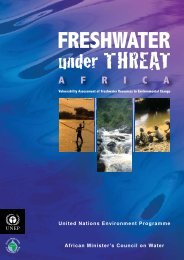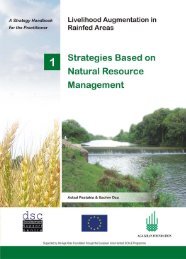Catalyzing Climate and Disaster Resilience: Processes for Identifying
Catalyzing Climate and Disaster Resilience: Processes for Identifying
Catalyzing Climate and Disaster Resilience: Processes for Identifying
You also want an ePaper? Increase the reach of your titles
YUMPU automatically turns print PDFs into web optimized ePapers that Google loves.
147<br />
they were only concerned with building control <strong>and</strong> compliance to building codes!<br />
(SLD with Rowal Town TMA, 2007). Sitting on the bank of the Lai with the early<br />
warning system in his premises, he did not realize how building st<strong>and</strong>ards in terms of<br />
plinth levels <strong>and</strong> control are an essential part of risk reduction in a flood plain.<br />
He did admit that building controls were not en<strong>for</strong>ced <strong>and</strong> that only after the collapse<br />
of a shopping plaza, the municipality woke up to the lack of en<strong>for</strong>cement. In addition,<br />
we realize that contour or flood maps of the Lai are not publicly available, as somehow<br />
this in<strong>for</strong>mation is sensitive to national security. Lack of such basic in<strong>for</strong>mation<br />
precludes the local government from taking proactive steps. Similarly, almost all of<br />
the other service providers in the Lai area, like health, education, water <strong>and</strong> sanitation,<br />
claimed that risk reduction was not their m<strong>and</strong>ate <strong>and</strong> some external structural<br />
measure was the only solution to avert risk in the Lai flood plain. However, appropriate<br />
building codes, zoning <strong>and</strong> en<strong>for</strong>cement may be the most cost effective measures <strong>for</strong><br />
risk reduction, which would not require any extra resource beyond what the local<br />
authorities are m<strong>and</strong>ated to do in their day-to-day responsibilities.<br />
Comparing Urban Flood Mitigation Options: Costs <strong>and</strong> Benefits<br />
in Rawalpindi, Pakistan<br />
Political versus techno-administrative underst<strong>and</strong>ing of DRR<br />
While DRR is considered strictly a technical <strong>and</strong> sectoral issue, the impetus <strong>for</strong> risk<br />
reduction comes from political <strong>for</strong>ces. The politicized nature of DRR is so well<br />
established in the area that some of the Civil Defence volunteers complained that the<br />
communities would sometimes not cooperate with them. The locals assumed that the<br />
Civil Defence was there to further some political motive <strong>and</strong> not help in reality. Despite<br />
the concrete risk reduction measure, Lai flooding has been used by politicians as<br />
means of gaining support from communities as they are photographed wading in<br />
knee-deep waters while making statements about providing relief to the affected<br />
communities (Daily Jang archives, 2007).<br />
The launch of “Lai Expressway” which was later renamed “Sheikh Rashid Expressway”<br />
was a maneuver in electioneering <strong>and</strong> pork barrel politics. Such large-scale intervention<br />
could not have been proposed by any single organization because of their sectoral<br />
m<strong>and</strong>ates <strong>and</strong> interests. It by-passed all the regular project preparation <strong>and</strong> approval<br />
stages as a “fast-track” investment made through the directive of the President of<br />
Pakistan. To get financial allocations, some documentation such as a Feasibility Report<br />
<strong>and</strong> an Environmental Impact Assessment were hastily prepared <strong>and</strong> missed critical<br />
issues like groundwater recharge due to paving of the riverbed with concrete. Expecting<br />
a governmental CBA of various options would have been unrealistic in this case, as it<br />
may have highlighted alternate options that were more cost effective. There<strong>for</strong>e, no<br />
government CBA was conducted to evaluate the Expressway project.<br />
Underst<strong>and</strong>ing concept of vulnerability <strong>and</strong> its nuances<br />
Vulnerability is a growing buzzword in the NGO circles, but often used more in relation<br />
to gender debates <strong>and</strong> the consequences of patriarchic systems. In government<br />
planning circles, vulnerability is equated to poverty. At the local level, although the<br />
communities may not be able to realistically fathom costs, they have a very good idea<br />
of vulnerabilities <strong>and</strong> their causes. What is clearly missing from the debate at various<br />
policy levels is the concept of building resilience in communities by addressing the<br />
root causes of vulnerability to reduce risk. As a result, provision of basic infrastructure


